You’ve probably heard of this CMS, but you still don’t know what Drupal is?
Let’s find out how this platform was created and how it has evolved up to date. In this article, What is Drupal?, let’s go over the features and functions.
If you’re wondering what’s possible with Drupal and how you can put the CMS to the test, you’ll find all the answers here in this article.
Let’s start by retracing the beginning of this CMS.
Table of Contents
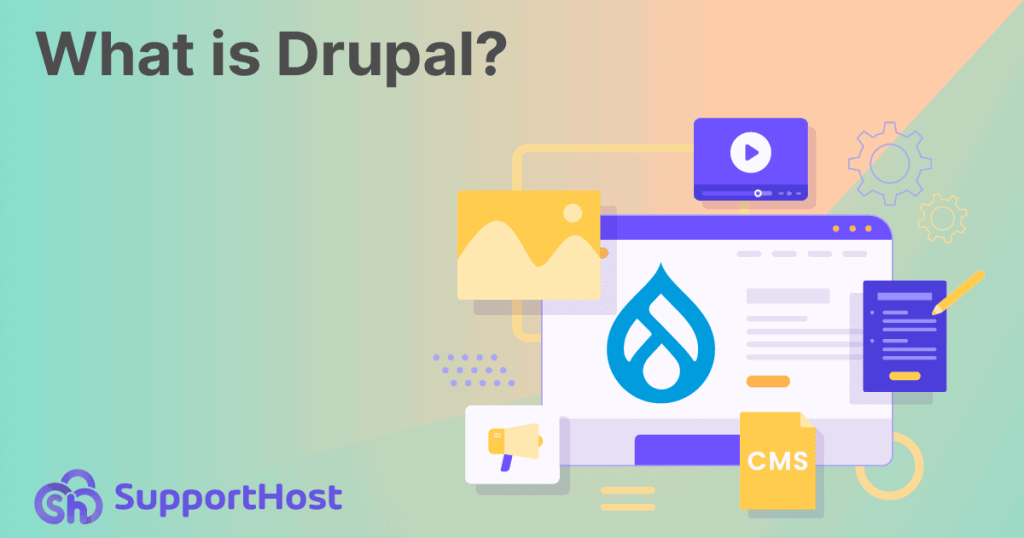
What is Drupal and how it was created
Drupal is a free open source CMS that was created in the year 2000 by two students from the University of Antwerp: Dries Buytaert and Hans Snijder.
The first version of Drupal was released in January 2001 to give everyone the opportunity to use the platform.
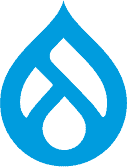
The choice of the name of this CMS is particular. Initially the domain name for this project was “dorp” which in Dutch means village and that represented the idea of community.
Due to a typo, however, Dries ended up registering the domain as “drop.org”.
When the first version of the software was released it was decided to change the name “drop” to “drupal” which comes from the pronunciation of “druppel” or drop in Dutch.
How many sites use Drupal?
The statistics of w3techs show that Drupal is used by 1.9% of websites that use a CMS and by 1.2% of the total number of sites worldwide.
In this chart you can see an overview of the most used CMS.
By visiting the showcase, you can see some of the sites that use Drupal as CMS.
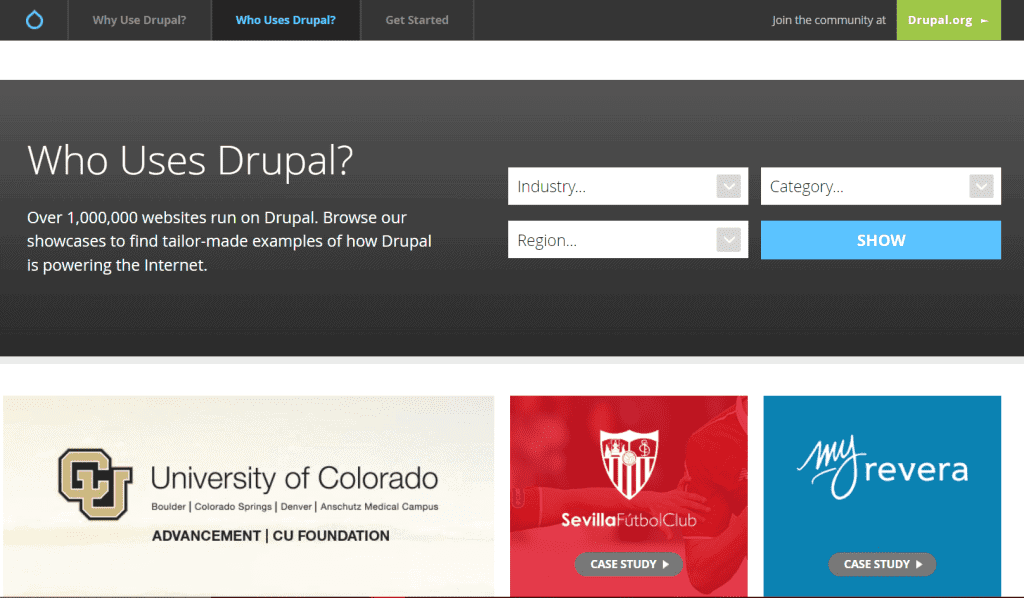
Drupal was born not only for blog creation and websites, but allows you to build online stores, social networks and complex applications.
What is Drupal in practice? You can think of this platform as both a content management system (CMS) and an actual framework.
Requirements of Drupal
Drupal 8 and later versions of the CMS are compatible with any web server (Apache, Nginx or Microsoft IIS), although Apache is generally the most widely used web server for this CMS.
It is important that the following requirements are compatible with the PHP version:
- Drupal 9: PHP 7.3 or 7.4 (minimum), PHP 8.0 or higher (recommended).
- Drupal 10: PHP 8.1 or higher.
Drupal, like other CMSs like WordPress or Joomla, needs a database to work with.
Recommended databases include MySQL, MariaDB and Percona Server.
For Drupal 9 and 10 the following is recommended:
- MySQL / Percona 5.7.8+
- MariaDB 10.3.7+.
How to try Drupal for free
The best way to understand what Drupal is and how it works is to do some testing yourself.
You can try Drupal with a test site on Simplytest.me, this test allows us to test an installation of the CMS for 12 hours.
If, instead, you want to try the CMS for a longer period you can take advantage of our free hosting trial hosting. When ordering you can request the installation of Drupal and then you will have 14 days to do all the tests you want.
The trial is non-binding and you can choose to upgrade to a Drupal hosting plan or simply let your trial plan expire.
Alternatively you can also try Drupal on your own computer. To install Drupal manually you can use a stack like XAMPP or MAMP to emulate a web server.
Features of Drupal
To better understand what Drupal is, let’s see what are the features of this open source CMS.
In this section we’re going to see what the structure of Drupal is and how content is managed.
We will also see what tools are provided to us regarding SEO management, customizing the look and feel of the site, and security.
But, first let’s understand if it’s easy to use Drupal and what resources can help us take our first steps.
Learning curve and resources
Drupal is a flexible CMS designed to create a variety of projects: from simple websites to complex applications.
At the same time, Drupal is also designed to be easy to use and, therefore, it is suitable even for users with little technical knowledge.
Its module structure means that with the right combination of elements you can create very different sites and applications: from a website to a blog, up to opening an online store or a social network.
Understanding how to use the modules and features, however, is not immediate. Drupal focuses on flexibility and customization, so in order to get the most out of this CMS you need to be prepared for a rather steep learning curve.
In any case on the site there is a manual guide that helps the user from content management to installation and configuration of the modules.
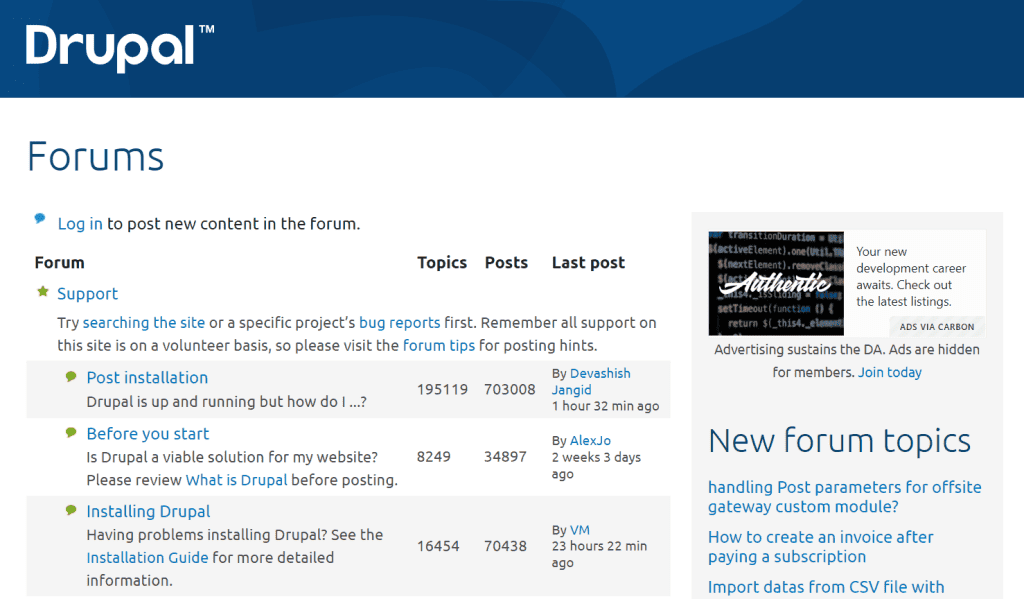
Besides the documentation you can count on a very active community with over 1 million members and a forum support system. The communities are also organized by languages or countries and you can consult all the lists on the site.
The structure of Drupal
To understand what Drupal is and how it works, we need to imagine a layered structure where we have:
- knots
- modules
- blocks and menus
- user permissions
- template.
The base of this structure is data, also called nodes. Any content, such as pages, articles, and so on, is stored as a node.
The top level is modules. A module is like a plugin that can be part of the Drupal core, i.e. constitute an integrated function in the CMS.
Modules can also be add-ons and then installed to extend Drupal’s functionality.
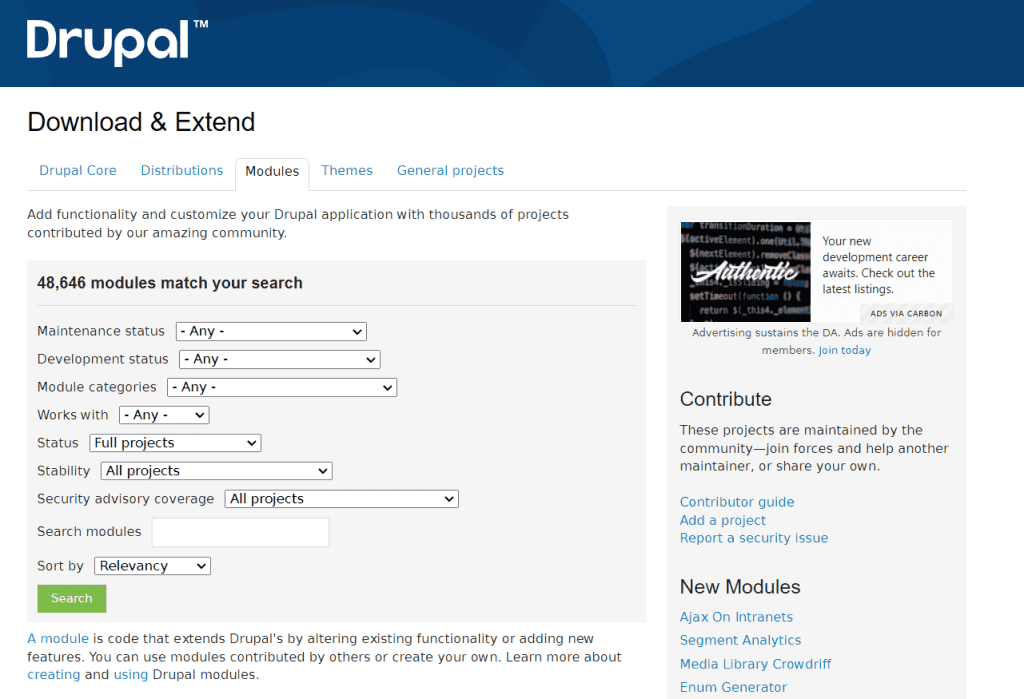
Above the modules, we find another level consisting of blocks and menus. Blocks are elements that will be displayed in the site and that can be positioned in different areas of the page, such as in the header or in the footer.
User permissions are the settings that allow you to define permissions for individual users.
At the last level of this structure we find the themes that allow us to determine the appearance of the site.
Content management and integrated functions
Now that we’ve seen what Drupal is, what it needs to work and what the key elements of the CMS are, let’s look at what the basic features are.
Drupal is available in multiple languages, and there are currently over 100 teams working on CMS localization. Moreover, multilingual support is among the features built into the core.
There are two types of content in Drupal: pages and articles. Articles can be used to create blog posts, news and similar content. Basic pages are the pages of the site such as the home page and contact page.
Drupal uses a WYSIWYG editor that allows us to see changes in real time content.
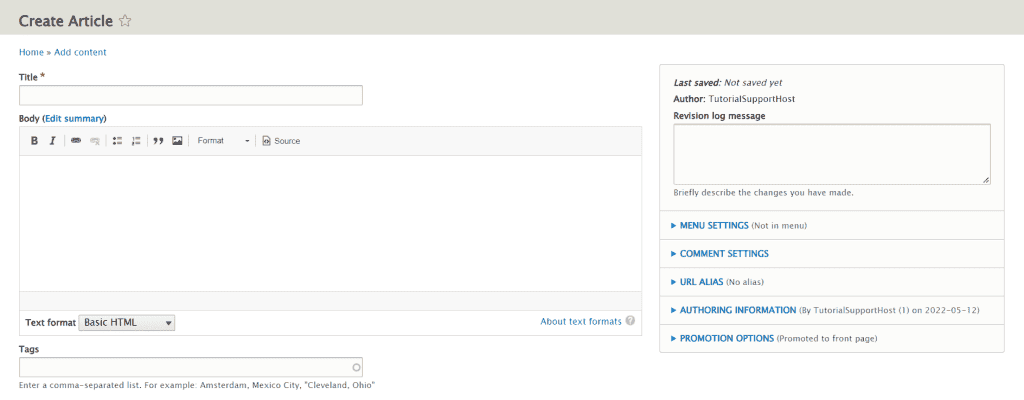
Drupal’s taxonomy for categorizing articles provides tags by default that can be used to group articles.
When we make changes to existing content, we can choose to keep track of the changes by saving a new revision. We can then browse the revisions, restore a previous version, or delete saved revisions.
Drupal Modules
As we said, we can create a web site with Drupal and extend its functions through modules. We can manage them directly from the back-end where we will find a series of modules ready to be activated.
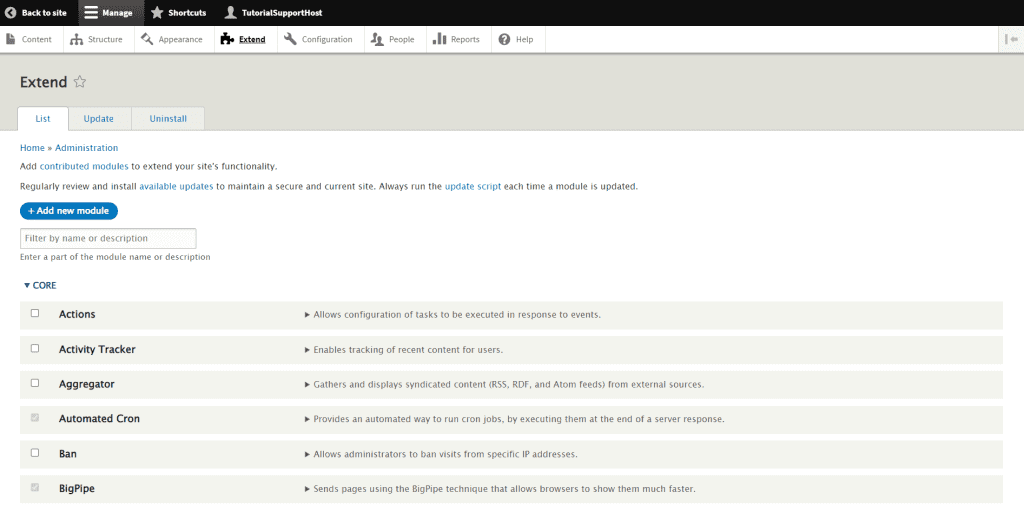
Among them is the activity tracker that allows us to monitor the activities of users who have accessed the site.
Core modules also include the ability to manage the cron job text editors like CKEditor and the creation of a contact form.
There are core modules and additional modules, in fact through the more than 48,000 modules available you can extend the functions of the CMS.
User Management
From the Drupal back-end we can also manage user permissions. We can create new users or change permissions for existing users.
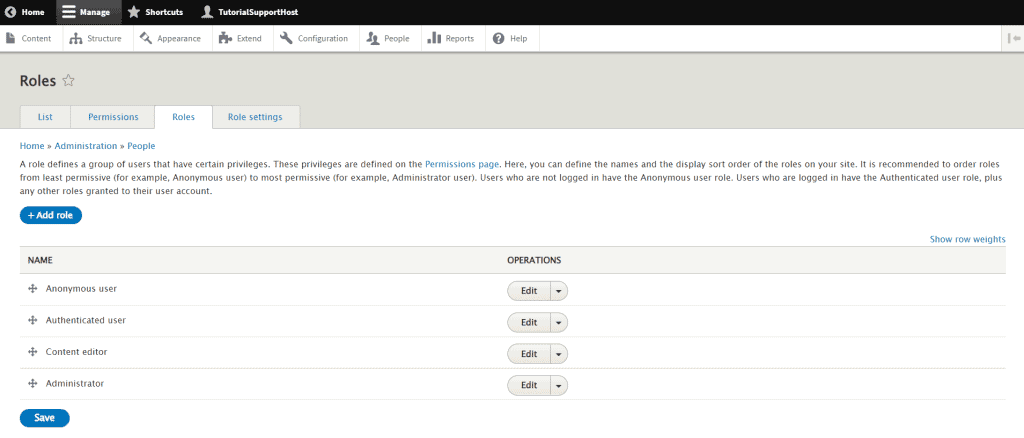
When creating a new user we can choose from three predefined roles.
Authenticated: is the minimum level, it distinguishes users who have access to the back-end from visitors.
Content editor: can create new content such as pages and articles, create taxonomy elements and so on.
Administrator: is the role with all permissions.
Roles have default permissions, but Drupal allows us to modify them and create new custom user roles.
SEO
With Drupal to optimize the site for SEO we can use different modules.
Through these modules and some integrated functions we can create the sitemap of the site, set SEO-friendly URLs and manage the 301 redirects.
There are also modules to integrate Google Analytics.
Themes
Drupal provides us with more than 3,000 themes with which you can change the appearance of the site.
From the administration area of the site we can check which themes are installed, add new ones or change the settings.
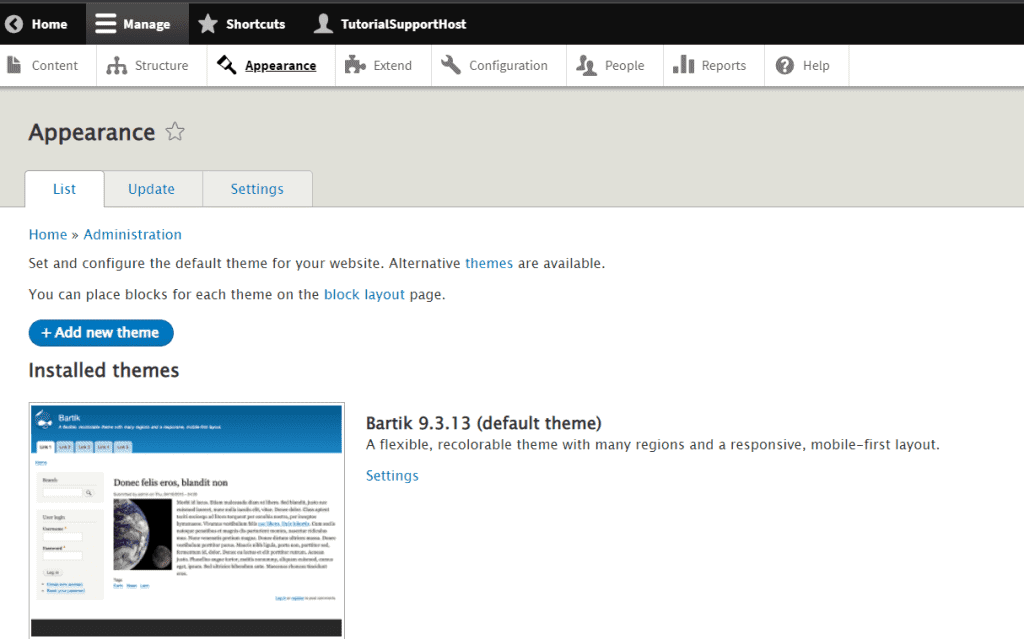
Security
To protect the security of a Drupal site there are several tools that are provided.
Through settings and roles management we can configure it so that only the administrator can create new accounts and assign permissions to new users.
From the administration area you can manage user roles and change permissions.
Also, as with all CMSs the golden rule is to always keep the core and modules up to date.
In fact, updates often also contain security patches that fix any vulnerabilities that have been discovered by the community.
When a new update is released a notification is sent to the site administrator. Also, to improve security external modules and themes are isolated from core files.
In terms of internal management, there is a security team that is responsible for reviewing reports, releasing patches, and providing support to those who release modules.
Conclusion
In this article, we have seen what Drupal is, how it was created and what are the features of the CMS.
The enormous flexibility of this CMS combined with the modular system makes it the right tool not only for creating websites, but also more complex applications and projects.
If we wanted to compare this CMS to the most currently used, the comparison Drupal vs WordPress would lead us to lean towards WordPress due to its ease of use. However, one could be drawn towards Drupal for the possibility of deeper management and much control on the settings.
Just think of some of the elements such as role management and multilingual support which are integrated in Drupal and do not require third-party modules or plugins.
What about you? Did you already know the features of this CMS? Have you chosen which platform to use to create your site? Let us know in the comments below.



Leave a Reply